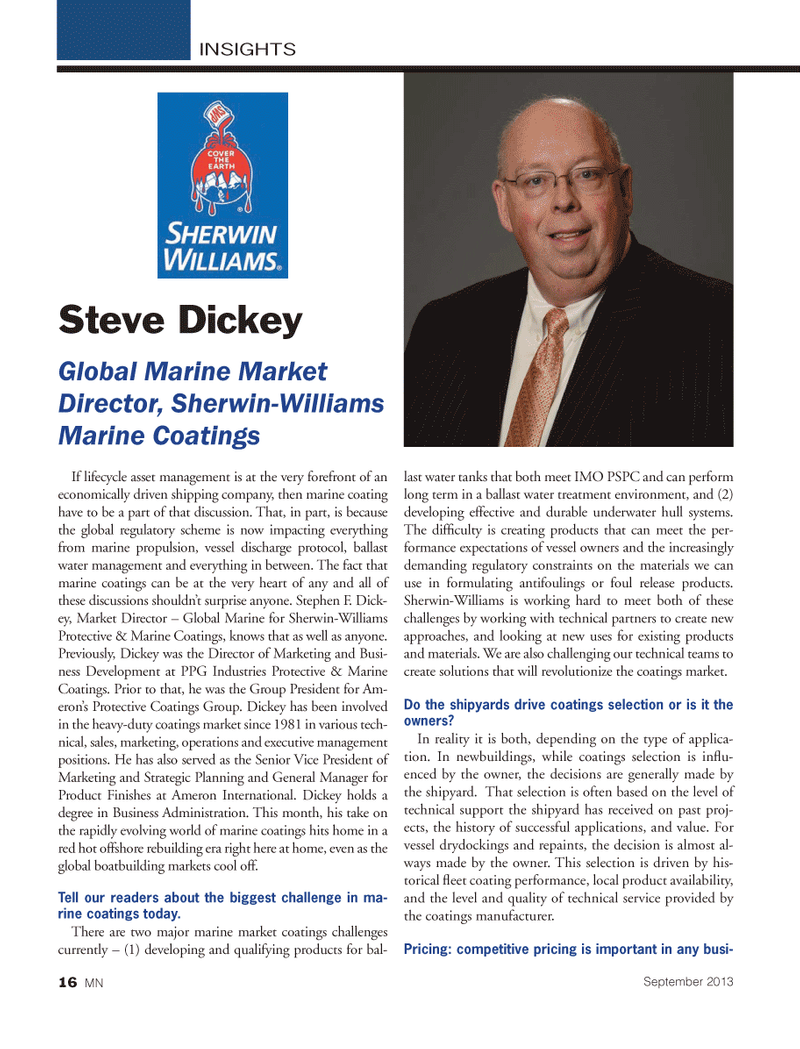
Page 16: of Marine News Magazine (September 2013)
Workboat Annual
Read this page in Pdf, Flash or Html5 edition of September 2013 Marine News Magazine
If lifecycle asset management is at the very forefront of an economically driven shipping company, then marine coating have to be a part of that discussion. That, in part, is because the global regulatory scheme is now impacting everything from marine propulsion, vessel discharge protocol, ballast water management and everything in between. The fact that marine coatings can be at the very heart of any and all of these discussions shouldnt surprise anyone. Stephen F. Dick- ey, Market Director ? Global Marine for Sherwin-Williams Protective & Marine Coatings, knows that as well as anyone. Previously, Dickey was the Director of Marketing and Busi- ness Development at PPG Industries Protective & Marine Coatings. Prior to that, he was the Group President for Am- erons Protective Coatings Group. Dickey has been involved in the heavy-duty coatings market since 1981 in various tech- nical, sales, marketing, operations and executive management positions. He has also served as the Senior Vice President of Marketing and Strategic Planning and General Manager for Product Finishes at Ameron International. Dickey holds a degree in Business Administration. This month, his take on the rapidly evolving world of marine coatings hits home in a red hot offshore rebuilding era right here at home, even as the global boatbuilding markets cool off. Tell our readers about the biggest challenge in ma- rine coatings today. There are two major marine market coatings challenges currently ? (1) developing and qualifying products for bal- last water tanks that both meet IMO PSPC and can perform long term in a ballast water treatment environment, and (2) developing effective and durable underwater hull systems. The dif? culty is creating products that can meet the per- formance expectations of vessel owners and the increasingly demanding regulatory constraints on the materials we can use in formulating antifoulings or foul release products. Sherwin-Williams is working hard to meet both of these challenges by working with technical partners to create new approaches, and looking at new uses for existing products and materials. We are also challenging our technical teams to create solutions that will revolutionize the coatings market. Do the shipyards drive coatings selection or is it the owners? In reality it is both, depending on the type of applica- tion. In newbuildings, while coatings selection is in? u- enced by the owner, the decisions are generally made by the shipyard. That selection is often based on the level of technical support the shipyard has received on past proj- ects, the history of successful applications, and value. For vessel drydockings and repaints, the decision is almost al- ways made by the owner. This selection is driven by his- torical ? eet coating performance, local product availability, and the level and quality of technical service provided by the coatings manufacturer. Pricing: competitive pricing is important in any busi- INSIGHTSSteve DickeyGlobal Marine Market Director, Sherwin-Williams Marine CoatingsSeptember 201316 MNMN Sept2013 Layout 1-17.indd 168/29/2013 11:11:19 AM

 15
15

 17
17
